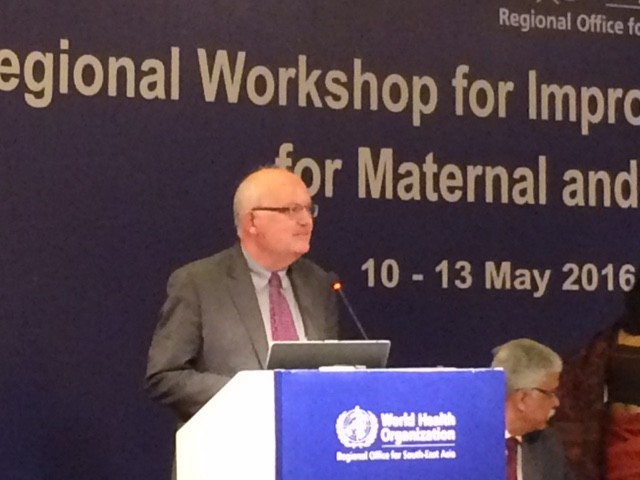
(As Prepared for Delivery)
Good morning distinguished guests, ladies and gentlemen.
It’s an honor for me to be here today to represent USAID at this very important workshop.
I would like to begin by congratulating the Ministries of Health and Family Welfare of the South East Asia region, and the World Health Organization for taking the lead in bringing all these countries together to discuss and share experiences in strengthening maternal and newborn care.
I will not begin by telling you how many infants and mothers continue to die in India and across the world. I believe we are all aware of the monumental challenge that faces all of us. Today, I would rather focus on telling you all what USAID and our partners have done right.
We are supporting innovations to reach our goal of saving the lives of mothers and children.
At USAID, we believe that every mother and child should be given the opportunity to survive and grow. Ending preventable child and maternal deaths means, first, giving children a healthy start by providing pregnant mothers with quality antenatal care and nutrition during pregnancy.
It means giving newborns a safe delivery, ensuring they are able to breathe in their first moments of life, ensuring no child dies of asphyxia. It means keeping newborns warm, sheltered, breastfed, and shielded from diseases like HIV.
Reducing child and maternal death means children and women are adequately nourished to avoid stunting and other diseases magnified by undernutrition. It means protecting children from infectious diseases like diarrhea, pneumonia, and malaria with existing and inexpensive technologies including vaccines, antibiotics, and bed-nets.
In India, we’ve seen compelling evidence that by scaling up key interventions; together we can save 4.3 million children and 128,000 women’s lives by 2020. By increasing water connections in the homes, we can save nearly 300,000 children. By scaling up the pneumonia vaccine, we can save over 250,000 children. And by increasing intrapartum interventions, like access to quality care during labor and delivery, we can save 30,000 women by 2020. This is an incredible opportunity.
I’m proud to say that USAID is assisting a wide range of health organizations at the local, national and global levels to make sure no child or mother is left behind.
At the global level, we have been privileged to work with World Health Organization (WHO) and other partners in the development of a new Global Quality of Care Framework, which will help standardize and build national capacities in quality care and coverage of services.
Through global projects such as “Applying Science to Strengthen and Improve Systems (ASSIST),” we have provided support to 23 countries to strengthen the quality of care for mother and children.
In Nepal, for example, our Health for Life project successfully strengthened the Government of Nepal’s capacity to plan, manage, and deliver high-quality and equitable family planning, maternal, newborn, and child health services.
In Bangladesh, we have developed a program called MaMoni or (Elder) that has achieved significant increases in deliveries with skilled birth attendants, referrals for maternal complications, and post-natal care, as well as improvements in family planning.
Here in India, USAID and the ASSIST project have together provided technical support to strengthen skills improvement among health providers in 26 high priority districts of India. ASSIST established quality improvement teams in 253 health facilities across these high-priority districts. In these USAID-supported facilities, neonatal mortality has been brought down by 13 percent compared to the national average of three percent.
Building on this success, we are now supporting India’s largest government hospital, the All India Institute of Medical Sciences, to build quality improvement capacity within so that it can become a center of excellence on quality improvement for the country.
Ultimately, the reason why workshops like these are important is that they tell us we are not alone in the struggle to save mothers and children who do not need to die. And because we can achieve results much faster if we combine our resources, skills, expertise, tools, and technologies.
Scientific, technological, and programmatic advances present an historic opportunity for the South East Asia region to accelerate progress in reducing preventable child and maternal deaths. I am confident that this workshop will inspire all of us to lead and accelerate our action plans for strengthening national capacity to improve quality of care through rich and meaningful deliberations and discussions over the next three days.
I’m also pleased to announce that we provided technical support to this regional workshop by drawing on our global public-private partnership called “Survive and Thrive”. As partners in this alliance, the American Academy of Pediatrics has worked with the ASSIST project. We are delighted to have senior representatives from the American Academy of Pediatrics, University of North Carolina, and the ASSIST project to serve as resource persons at this workshop. Together, the American Academy of Pediatrics and ASSIST have developed a toolkit on the nuts and bolts of how to improve quality of care within a health facility.
I am pleased to say that this toolkit will be shared at this workshop and we hope that it will be useful as you make quality a part of the culture of health care.
Thank you.







Comment
Make a general inquiry or suggest an improvement.